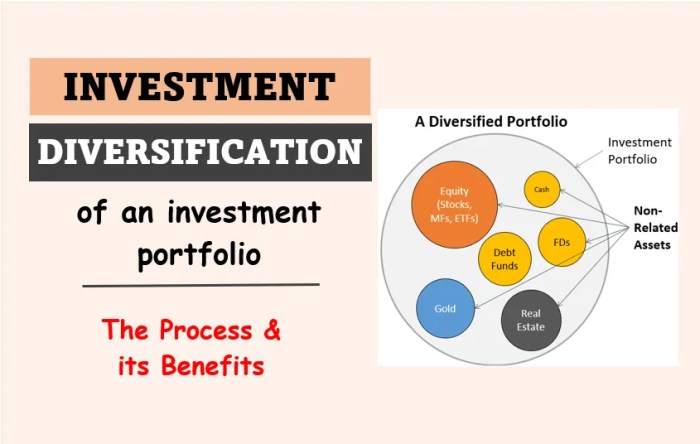Diving into the world of investment diversification opens up a realm of opportunities for financial growth and stability. By spreading your investments across different assets, you’re not just playing it safe – you’re setting yourself up for success in the unpredictable landscape of finance.
As we delve deeper into this topic, you’ll uncover the strategies, risks, and rewards that come with diversifying your investment portfolio. Get ready to revolutionize your approach to investing!
Importance of Investment Diversification
Diversifying investments is crucial for financial stability as it helps spread risk across different asset classes, reducing the impact of market fluctuations on a single investment.
Mitigating Risks through Diversification
- Diversifying across various industries: By investing in different sectors such as technology, healthcare, and consumer goods, you can minimize the impact of a downturn in any one industry.
- Asset allocation: Allocating your investments between stocks, bonds, real estate, and cash can help balance risk and return, ensuring your portfolio is not overly exposed to a single asset class.
- Geographical diversification: Investing in both domestic and international markets can protect your portfolio from country-specific risks such as political instability or economic downturns.
Impact of Not Diversifying Investments
Not diversifying investments can have a significant negative impact on a portfolio. If all your money is invested in a single stock or industry that experiences a downturn, you could lose a substantial portion of your wealth. This lack of diversification exposes you to higher levels of risk and volatility, making it harder to recover from losses.
Strategies for Investment Diversification
Investment diversification is a key strategy to manage risk and maximize returns in a portfolio. By spreading investments across different assets, industries, and regions, investors can reduce exposure to the volatility of any single investment. Let’s explore some effective strategies for diversifying your investment portfolio.
Different Methods to Diversify an Investment Portfolio
- Asset Allocation: This involves spreading investments across different asset classes like stocks, bonds, real estate, and commodities. By diversifying within asset classes, you can reduce risk and improve returns.
- Industry Diversification: Investing in companies across various industries helps mitigate the impact of sector-specific risks. For example, a downturn in one industry may not significantly affect the entire portfolio.
- Geographic Diversification: By investing in assets from different regions, you can reduce the impact of economic and political events that may affect a specific country or region.
- Company Size Diversification: Allocating funds across companies of different market capitalizations, such as large-cap, mid-cap, and small-cap stocks, can help balance risk and return potential.
Comparing and Contrasting Asset Allocation Strategies for Diversification
- Static Asset Allocation: Involves setting a target allocation for different asset classes and rebalancing periodically to maintain the desired mix.
- Dynamic Asset Allocation: Adjusts the allocation based on market conditions and economic outlook to capitalize on opportunities and reduce risks.
- Tactical Asset Allocation: Combines elements of both static and dynamic strategies, allowing for adjustments based on short-term market trends while maintaining a long-term perspective.
Benefits of Diversifying Across Different Industries or Geographic Regions
- Reduces Concentration Risk: Diversifying across industries or regions helps mitigate the impact of adverse events in a specific sector or country.
- Enhances Opportunities: Investing in diverse industries or regions exposes investors to a wider range of growth opportunities and potential market outperformance.
- Improves Risk-Adjusted Returns: By spreading investments across different sectors or countries, investors can achieve a better risk-return tradeoff in their portfolios.
Types of Assets for Diversification
When it comes to diversifying your investment portfolio, it’s essential to consider various asset classes to spread out risk and maximize returns. Let’s explore the different types of assets that can be used for diversification.
Traditional Assets vs. Alternative Assets
Traditional assets such as stocks and bonds are well-known investment options that most people are familiar with. Stocks represent ownership in a company, while bonds are debt securities issued by corporations or governments. On the other hand, alternative assets like real estate and commodities offer unique opportunities for diversification.
- Stocks: Investing in stocks allows you to participate in the growth of companies and benefit from capital appreciation.
- Bonds: Bonds provide a fixed income stream through interest payments and are considered less volatile than stocks.
- Real Estate: Investing in real estate can offer a hedge against inflation and provide a steady income stream through rental payments.
- Commodities: Commodities like gold, silver, and oil can act as a store of value and a hedge against economic uncertainty.
Enhancing Portfolio with Alternative Assets
Diversifying into alternative assets can bring unique benefits to a portfolio by reducing correlation with traditional assets and enhancing overall returns. For example, during periods of economic instability, investments in real estate and commodities may perform better than stocks and bonds, providing a cushion against market downturns.
By including alternative assets in your investment mix, you can create a well-rounded portfolio that is better positioned to weather different market conditions and achieve long-term financial goals.
Risks and Challenges in Investment Diversification

When it comes to investment diversification, there are certain risks and challenges that investors need to be aware of in order to effectively manage their portfolios.
Common Risks Associated with Investment Diversification
- Market Risk: Diversifying across different asset classes does not eliminate market risk entirely. If the entire market experiences a downturn, all assets may be affected.
- Over-Diversification: Diversifying too much can lead to diluted returns, making it difficult to outperform the market.
- Correlation Risk: Some assets may be more correlated than others, meaning they move in the same direction during market fluctuations.
Challenges Investors May Face When Attempting to Diversify Their Portfolio
- Lack of Knowledge: Investors may struggle to understand the complexities of different asset classes and how they interact with each other.
- Emotional Bias: Fear or greed can lead investors to make impulsive decisions that go against the principles of diversification.
- Costs and Fees: Maintaining a diversified portfolio can come with additional fees and costs that eat into overall returns.
Strategies to Overcome Obstacles in Achieving Effective Investment Diversification
- Asset Allocation: Determine the right mix of assets based on your risk tolerance and investment goals to achieve diversification without overdoing it.
- Regular Rebalancing: Periodically review and adjust your portfolio to maintain the desired asset allocation and risk level.
- Stay Informed: Continuously educate yourself about different asset classes and market trends to make informed decisions.






